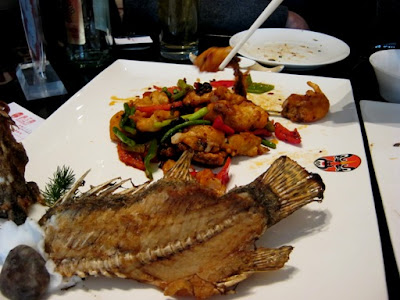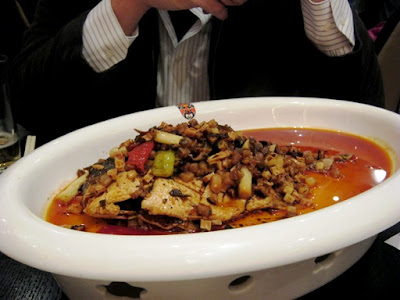The first time I tried Sichuan food (also called Szechuan cuisine), I actually spit it out (sorry to be gross!) as a reflex when some of the hot peppercorns slid down my throat. Marc wanted to die of embarrassment, while I just simply turned red with watery eyes and started coughing up a storm. I was definitely an amateur at trying the famous Sichuan peppercorn. We were in a small Sichuan restaurant back in Hangzhou in 2009 eating steamed fish soup with chili peppercorns. After that incident, I vowed never to try Sichuan food ever again. I thought, this is crazy spicy and it’s really not for me.
As time passed however, Marc convinced me to give it another chance since he simply loves Sichuan food, and because of the fact that along with Cantonese, Shandong and Jiangsu cuisine, Sichuan cuisine is one of the best known and influential cuisines in China. So I gave it another go and what do you know? Lo and behold, I now actually find myself craving Sichuan food from time to time. After trying other dishes and opening my mind and taste buds to its fiery and bold flavors once again, I admit it won me over and I am now partially hooked.
After all, I’ve always liked spicy dishes, as long as it doesn’t go to the extreme. I love Thai food and Indian food and I always put hot sauce on my pizza. I believe a little chili really gives food that extra kick. So I just had to learn which dishes to pick and when not to overdo the spice.
 |
| SICHUAN DRY-FRIED GREEN BEANS (YUMMY!) |
I’ve also learned in trying different Sichuan dishes that the cuisine is not all about “hot and spicy” but that the cuisine is really all about emphasizing bold flavors through the use of garlic (yum!), chili peppers, Sichuan peppercorn, peanuts, sesame paste, broad bean chili paste, chili oil and ginger. Sichuan cuisine is actually composed of seven basic flavors: sour, pungent, hot, sweet, bitter, aromatic and salty.
 |
| DEEP FRIED FISH WITH CHILI AND PEPPERCORNS |
For starters, the landscape of Sichuan province has a lot to do with the development of their cuisine. Sichuan province (also the home of the beloved pandas) is known as “heavenly country” to the Chinese due to the province’s abundance of food and natural resources. The people from this area believe in strong, good flavor and are fond of hot and spicy tastes. Usually most of the dishes are stir-fried, steamed and braised.
 |
BRAISED POMFRET WITH PORK RELISH
AND SWEET & SPICY SAUCE |
The most well-known dishes are the Kung Pao Chicken and Spicy Dan Dan Noodles. Chengdu, the capital of Sichuan province, has been declared by UNESCO as a city of Gastronomy in 2011 due to its award-winning Sichuan style of cooking.
 |
STIR-FRIED KUNG PAO CHICKEN (MY FAVORITE!)
THIS IS JUST DELICIOUS!! |
Are you ready for some spice? If so, here’s an easy Sichuan recipe that anyone can try at home anytime.
STIR-FRY KUNG PAO CHICKEN RECIPE
(copied from chinesefood.about.com)
2 boneless, skinless chicken breasts, 7 to 8 ounces each
Marinade:
2 teaspoons soy sauce
2 teaspoons Chinese rice wine or dry sherry
1 teaspoon sesame oil
1 1/2 teaspoons cornstarch
Sauce:
2 tablespoons dark soy sauce
1 tablespoon Chinese rice wine or dry sherry
1 teaspoon sugar
Other:
8 small dried red chili peppers
2 cloves garlic
2 green onions (spring onions, scallions)
4 tablespoons oil for stir-frying, or as needed
1 teaspoon Sichuan peppercorn, optional
1/2 cup peanuts or cashews
few drops sesame oil, optional
Preparation:
1. Cut the chicken into 1-inch cubes. Combine with the marinade ingredients, adding the cornstarch last. Marinate the chicken for 25 minutes.
2. While the chicken is marinating, prepare the sauce and vegetables: In a small bowl, combine the dark soy sauce, rice wine, and sugar. Set aside.
3. Cut the chilies in half so that they are approximately the same size as the chicken cubes. Remove the seeds. Peel and finely chop the garlic. Cut the green onion on the diagonal into thirds.
4. Heat the wok over medium-high to high heat. Add 2 tablespoons oil. When the oil is hot, add the chicken. Stir-fry until it turns white and is 80 percent cooked. Remove from the wok.
5. Add 2 tablespoons oil. When the oil is hot, add the garlic and stir-fry until aromatic (about 30 seconds). Add the chili peppers and the Sichuan peppercorn if using. Stir-fry briefly until they turn dark red.
6. Add the sauce to the wok. Bring to a boil. Add the chicken back into the pan. Stir in the peanuts and the green onion. Remove from the heat and stir in the sesame oil. Serve hot.
Enjoy!!
Some great Sichuan restaurants in China:
SOUTH BEAUTY RESTAURANTS (all around China)
SICHUAN CITIZEN
30 Donghu Lu, near Huaihai Lu (French Concession)
Shanghai
Phone: (86 21) 5404 1235
MAURYA (Sichuan and Cantonese cuisine)
75 Mengzi Dong Lu, near Liyuan Lu (French Concession)
Shanghai
Phone: (86 21) 3307 0770